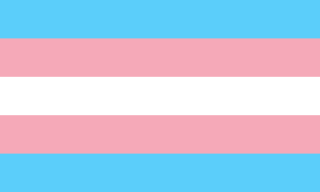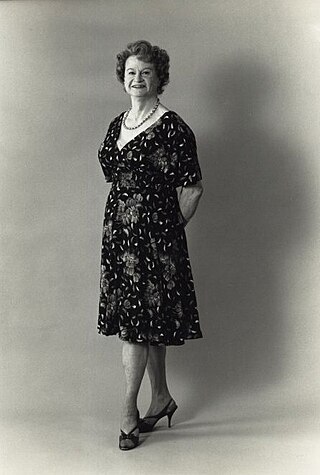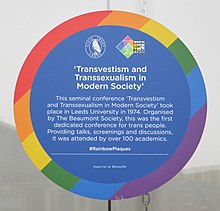
Transvestism is the practice of dressing in a manner traditionally or stereotypically associated with a different gender. In some cultures, transvestism is practiced for religious, traditional, or ceremonial reasons. The term is considered outdated in Western cultures, especially when used to describe a transgender or gender-fluid person.
The following outline is provided as an overview of and topical guide to transgender topics.
The American-Canadian sexologist Ray Blanchard proposed a psychological typology of gender dysphoria, transsexualism, and fetishistic transvestism in a series of academic papers through the 1980s and 1990s. Building on the work of earlier researchers, including his colleague Kurt Freund, Blanchard categorized trans women into two groups: homosexual transsexuals who are attracted exclusively to men and are feminine in both behavior and appearance; and autogynephilic transsexuals who experience sexual arousal at the idea of having a female body. Blanchard and his supporters argue that the typology explains differences between the two groups in childhood gender nonconformity, sexual orientation, history of sexual fetishism, and age of transition.

Sexuality in transgender individuals encompasses all the issues of sexuality of other groups, including establishing a sexual identity, learning to deal with one's sexual needs, and finding a partner, but may be complicated by issues of gender dysphoria, side effects of surgery, physiological and emotional effects of hormone replacement therapy, psychological aspects of expressing sexuality after medical transition, or social aspects of expressing their gender.
The Sex Orientation Scale (SOS) was Harry Benjamin's attempt to classify and understand various forms and subtypes of transvestism and transsexualism in biological males, published in 1966. It was a seven-point scale ; it was analogous to the Kinsey Scale as it relates to sexual orientation, which also had seven categories.
Fantasia Fair is a week-long conference for cross-dressers, transgender and gender questioning people held every October in Provincetown, Massachusetts, a small Portuguese fishing village and largely gay and lesbian tourist village on the very tip of Cape Cod. This annual event is the longest-running transgender conference in the United States and it provides a week for attendees to experiment with gender-role identities and presentations in a safe and affirming community. The goal of the conference is to create a safe space in which crossdressers, transgender and transsexual people, and nonbinary-gendered people are accepted without judgement, can interact with their peers, and can advocate for their rights. In November, 1980 the event was featured in an article by D. Keith Mano in Playboy magazine and has in ensuing years has continued to generate publicity.
The classification of transsexual and gender non-conforming people into distinct groups has been attempted since the mid-1960s.

The term travesti is used in Latin America to designate people who were assigned male at birth and develop a feminine gender identity. Other terms have been invented and are used in South America in an attempt to further distinguish it from cross-dressing, drag, and pathologizing connotations. In Spain, the term was used in a similar way during the Franco era, but it was replaced with the advent of the medical model of transsexuality in the late 1980s and early 1990s, in order to rule out negative stereotypes. The arrival of these concepts occurred later in Latin America than in Europe, so the concept of travesti lasted, with various connotations.
Mak Nyah, alternatively spelled maknyah, is a Malay vernacular term for trans women in Malaysia. It arose in the late 1980s in order to distinguish trans women from other minorities.

A transgender person is someone whose gender identity differs from that typically associated with the sex they were assigned at birth. Some transgender people who desire medical assistance to transition from one sex to another identify as transsexual. Transgender is also an umbrella term; in addition to including people whose gender identity is the opposite of their assigned sex, it may also include people who are non-binary or genderqueer. Other definitions of transgender also include people who belong to a third gender, or else conceptualize transgender people as a third gender. The term may also include cross-dressers or drag kings and drag queens in some contexts. The term transgender does not have a universally accepted definition, including among researchers.

Louis Graydon Sullivan was an American author and activist known for his work on behalf of trans men. He was perhaps the first transgender man to publicly identify as gay, and is largely responsible for the modern understanding of sexual orientation and gender identity as distinct, unrelated concepts.

Virginia Charles Prince, born Arnold Lowman, was an American transgender activist. She published Transvestia magazine, and started Full Personality Expression , which later became Tri-Ess, for male heterosexual cross-dressers.

The following outline offers an overview and guide to LGBT topics.
LGBT culture in Leeds, England, involves an active community of people who identify as lesbian, gay, bisexual, or transgender/transsexual. A BBC News Online article published in 2012 stated that, while Leeds City Council has not published statistics relating to the number of LGBT residents, the figure can be estimated at 10% of the overall population, which currently suggests a total of at least 77,000. The tenth year of the Leeds Pride march and celebration, held in 2016, was attended by over 40,000 people.

A transvestite pass was a doctor's note recognized by the governments of Imperial Germany and the Weimar Republic – under the support of sexologist Magnus Hirschfeld – identifying a person as a transvestite. Transvestite at this time referred to all individuals whose gender identity or preferred clothing was discordant to that associated with their assigned sex, and so included both cross-dressing and transgender people. As gender-confirming surgery was only an emerging practice in the early 20th century, obtaining a Transvestitenschein, along with an official name change, represented the maximum extent to which many trans individuals could transition.

This article addresses the history of transgender people across the British Isles in the United Kingdom, the British colonies and the Kingdom of England until the present day. Transgender people were historically recognised in the UK by varying titles and cultural gender indicators, such as dress. People dressing and living differently from their sex assignment at birth and contributing to various aspects of British history and culture have been documented from the 14th century to the present day. In the 20th century, advances in medicine, social and biological sciences and transgender activism have influenced transgender life in the UK.

The Transsexual Phenomenon is a medical textbook published by American endocrinologist and sexologist Harry Benjamin in 1966 with The Julian Press. The text is notable for its examination of transsexualism not as a psychological issue, but rather as a somatic disorder that should be treated through medicine. Benjamin argues that transvestism and transsexuality are a spectrum of conditions, requiring different treatments that ranged from hormone replacement therapy to surgical intervention.
Carol S. Riddell is a British feminist and socialist sociologist and transgender lesbian who was active in the UK Women's liberation movement in the 1970s. She is known for authoring Divided Sisterhood, the first feminist critique of Janice Raymond's book The Transsexual Empire.
The Beaumont Society is a human rights organisation based in the United Kingdom, which is run by transgender people for to support their community.
Della Aleksander was a teacher and campaigner for trans rights. She was a co-producer of an episode of the current affairs programme Open Door, which was the first to feature trans women. She was a member of fascist organisations, such as the League of St George.










